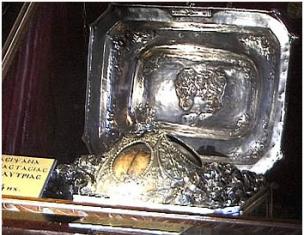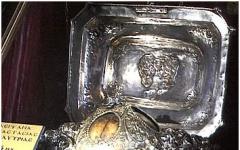There are a large number of different circuit solutions, but in our case we will analyze several PWM options LED brightness control() on the PIC microcontroller.
PIC10F320/322 is an ideal option for designing various dimmers. At the same time, we acquire a fairly sophisticated device with the lowest cost and minimal time spent on construction. Let's look at several dimmer options.
First option. A basic LED brightness control in which the brightness of the LEDs is changed by rotating the variable knob, while the brightness changes from 0 to 100%
The brightness of the LEDs is set by removing the potential from the variable resistor R1. This variable voltage goes to the RA0 input, which functions as an analog input and is connected to the AN2 input of the microcontroller ADC. The PWM pin RA1 controls the power switch on transistor V1.
It is possible to choose an arbitrary power transistor with a logical control level, that is, these are those transistors that, when receiving 1...2 volts to the gate, completely open their channel.
For example, with the IRF7805 transistor it is possible to control a current of up to 13 amperes while meeting the necessary requirements, and under any other conditions up to 5 amperes are guaranteed. Connector CON1 is needed only for in-circuit programming of the microcontroller; for the same purpose, resistances R2 and R5 are also needed, that is, if the microcontroller is programmed, then all these radio elements may not be installed.
Resistance R4 and BAV70 serve to protect against overvoltage and improper connection of the power supply. Capacitors C1 and C2 are ceramic and serve to reduce impulse noise and for reliable operation of the LM75L05 stabilizer.
Second option. Here, the brightness of the LEDs is also controlled by a variable resistor, and switching on and off is done using buttons.

Third option. As you can see, there is no variable resistor in the circuit. In this version, the brightness of the LEDs is controlled exclusively by two buttons. The adjustment is stepwise, the brightness changes with each subsequent press.

Fourth option. Essentially the same as the third option, but when you hold down the button, the LED glow changes smoothly.
LEDs are used in almost all technology around us. True, sometimes it becomes necessary to adjust their brightness (for example, in flashlights or monitors). The easiest way out in this situation seems to be to change the amount of current passed through the LED. But that's not true. The LED is a fairly sensitive component. Constantly changing the amount of current can significantly shorten its life, or even break it. It is also necessary to take into account that you cannot use a limiting resistor, since excess energy will accumulate in it. This is unacceptable when using batteries. Another problem with this approach is that the color of the light will change.
There are two options:
- PWM regulation
- Analog
These methods control the current flowing through the LED, but there are certain differences between them.
Analog control changes the level of current that passes through the LEDs. And PWM regulates the frequency of current supply.
PWM regulation
A way out of this situation may be to use pulse width modulation (PWM). With this system, the LEDs receive the required current, and the brightness is adjusted using high-frequency power supply. That is, the frequency of the feeding period changes the brightness of the LEDs.
The undoubted advantage of the PWM system is maintaining the productivity of the LED. The efficiency will be about 90%.
Types of PWM regulation
- Two-wire. Often used in car lighting systems. The converter's power supply must have a circuit that generates a PWM signal at the DC output.
- Shunt device. To make the on/off period of the converter use a shunt component that provides a path for the output current other than the LED.
Pulse parameters for PWM
The pulse repetition rate does not change, so there are no requirements for it in determining the brightness of the light. In this case, only the width, or time, of the positive pulse changes.

Pulse frequency
Even taking into account the fact that there are no special complaints about the frequency, there are limit values. They are determined by the sensitivity of the human eye to flickering. For example, in a movie, frames must flash at 24 frames per second for our eyes to perceive it as one moving image.
In order for flickering light to be perceived as uniform light, the frequency must be at least 200 Hz. There are no restrictions on the upper indicators, but there is no way lower.
How does a PWM regulator work?
A transistor key stage is used to directly control the LEDs. Typically, they use transistors that can accumulate large amounts of power.
This is necessary when using LED strips or high-power LEDs.
For small quantities or low power, the use of bipolar transistors is sufficient. You can also connect LEDs directly to microcircuits.
PWM generators
In a PWM system, a microcontroller or a circuit consisting of low-integration circuits can be used as a master oscillator.
It is also possible to create a regulator from microcircuits that are designed for switching power supplies, or K561 logic chips, or NE565 integrated timer.
Craftsmen even use an operational amplifier for these purposes. To do this, a generator is assembled on it, which can be adjusted.
One of the most used circuits is based on the 555 timer. It is essentially a regular square wave generator. The frequency is regulated by capacitor C1. at the output the capacitor must have a high voltage (this is the same with the connection to the positive power supply). And it charges when there is a low voltage at the output. This moment gives rise to pulses of different widths.
Another popular circuit is PWM based on the UC3843 chip. in this case, the switching circuit has been changed towards simplification. In order to control the pulse width, a control voltage of positive polarity is used. In this case, the output produces the desired PWM pulse signal.
The regulating voltage acts on the output as follows: as it decreases, the width increases.

Why PWM?
- The main advantage of this system is its ease. The usage patterns are very simple and easy to implement.
- The PWM control system provides a very wide range of brightness adjustment. If we talk about monitors, it is possible to use CCFL backlight, but in this case the brightness can only be reduced by half, since CCFL backlight is very demanding on the amount of current and voltage.
- Using PWM, you can keep the current at a constant level, which means the LEDs will not be damaged and the color temperature will not change.
Disadvantages of using PWM
- Over time, image flicker can become quite noticeable, especially at low brightness or with eye movement.
- Under constant bright light (such as sunlight), the image may become blurry.
Every radio amateur is familiar with the NE555 microcircuit (analogous to KR1006). Its versatility allows you to design a wide variety of homemade products: from a simple single-vibrator pulse with two elements in the harness to a multi-component modulator. This article will discuss the circuit for switching on a timer in the mode of a rectangular pulse generator with pulse-width adjustment.
Scheme and principle of its operation
With the development of high-power LEDs, NE555 again entered the arena as a dimmer, recalling its undeniable advantages. Devices based on it do not require deep knowledge of electronics, are assembled quickly and work reliably.
It is known that the brightness of an LED can be controlled in two ways: analog and pulse. The first method involves changing the amplitude value of the direct current through the LED. This method has one significant drawback - low efficiency. The second method involves changing the pulse width (duty factor) of the current with a frequency from 200 Hz to several kilohertz. At such frequencies, the flickering of LEDs is invisible to the human eye. The circuit of a PWM regulator with a powerful output transistor is shown in the figure. It is capable of operating from 4.5 to 18 V, which indicates the ability to control the brightness of both one powerful LED and an entire LED strip. The brightness adjustment range ranges from 5 to 95%. The device is a modified version of a rectangular pulse generator. The frequency of these pulses depends on the capacitance C1 and resistances R1, R2 and is determined by the formula: f=1/(ln2*(R1+2*R2)*C1), Hz
The operating principle of the electronic brightness control is as follows. At the moment the supply voltage is applied, the capacitor begins to charge through the circuit: +Usupply – R2 – VD1 –R1 –C1 – -Usupply. As soon as the voltage on it reaches the level of 2/3U, the internal timer transistor will open and the discharge process will begin. The discharge begins from the top plate of C1 and further along the circuit: R1 – VD2 –7 IC pin – -U supply. Having reached the 1/3U mark, the timer power transistor will close and C1 will again begin to gain capacity. Subsequently, the process is repeated cyclically, forming rectangular pulses at pin 3.
Changing the resistance of the trimming resistor leads to a decrease (increase) in the pulse time at the timer output (pin 3), and as a result, the average value of the output signal decreases (increases). The generated sequence of pulses is supplied through the current-limiting resistor R3 to the gate VT1, which is connected according to a circuit with a common source. The load in the form of an LED strip or sequentially connected high-power LEDs is connected to the open drain circuit VT1.
In this case, a powerful MOSFET transistor with a maximum drain current of 13A is installed. This allows you to control the glow of an LED strip several meters long. But the transistor may require a heat sink.
Blocking capacitor C2 eliminates the influence of interference that may occur along the power circuit when the timer is switched. The value of its capacitance can be any within the range of 0.01-0.1 µF.
Board and assembly parts of the brightness control
 The single-sided printed circuit board has dimensions of 22x24 mm. As you can see from the picture, there is nothing superfluous on it that could raise questions.
The single-sided printed circuit board has dimensions of 22x24 mm. As you can see from the picture, there is nothing superfluous on it that could raise questions.
After assembly, the PWM dimmer circuit does not require adjustment, and the printed circuit board is easy to make with your own hands. The board, in addition to the tuning resistor, uses SMD elements.
- DA1 – IC NE555;
- VT1 – field effect transistor IRF7413;
- VD1,VD2 – 1N4007;
- R1 – 50 kOhm, trim;
- R2, R3 – 1 kOhm;
- C1 – 0.1 µF;
- C2 – 0.01 µF.
Transistor VT1 should be selected depending on the load power. For example, to change the brightness of a one-watt LED, a bipolar transistor with a maximum permissible collector current of 500 mA will be sufficient.
The brightness of the LED strip must be controlled from a +12 V voltage source and match its supply voltage. Ideally, the regulator should be powered by a stabilized power supply specifically designed for tape.
The load in the form of individual high-power LEDs is powered differently. In this case, the dimmer's power source is a current stabilizer (also called an LED driver). Its rated output current must match the current of the LEDs connected in series.
Read also
LEDs are becoming more and more common in our daily lives. We change incandescent lamps in an apartment or house, halogen lamps in a car with LED ones. In order to regulate the brightness of an Addison bulb, a dimmer is usually used - this is a thing with which you can limit the alternating current, thereby changing the brightness of the glow to the one you need. Why pay more, and even feel discomfort due to excessively bright light? The power regulator can generally be used for many consumers (soldering iron, grinder, vacuum cleaner, drill...) from alternating mains voltage; they are usually built on the basis of a triac.
LEDs are powered by direct and stabilized current, so a standard dimmer cannot be used here. If you simply change the voltage supplied to it, the brightness will change very sharply, current is important for them, but instead of a current regulator we will do something else, namely PWM (Pulse Wide Modulator), it will turn off the power supply from the LED for a certain time, the brightness will decrease, but we will not notice the blinking, since the frequency is such that the human eye will not notice it. Microcontrollers are not used here, because their presence can become an obstacle to assembling the device; you need to have a programmer, certain software... Therefore, in this simple circuit only simple and publicly available radio components are used.
This kind of thing can be used for any inertial loads, that is, those that can store energy, because if, for example, you disconnect a DC motor from the power source, it will not immediately stop rotating.
The circuit, in my opinion, can be roughly divided into two parts, namely a generator made on the mega-popular timer NE555 (analogue -KR1006VI1) and a powerful opening/closing transistor, with the help of which power is supplied to the load (here the 555 operates in the astable multivibrator). We use a powerful bipolar transistor NPN structure (I took TIP122), but it is possible to replace it with a field-effect (MOSFET) transistor. The pulse generator frequency, period, and pulse duration are set by two resistors (R3, R2) and capacitors (C1, C2), and we can change it with a resistor with resistance adjustment.
Schematic components
There are a lot of programs for calculating the 555 analog timer, you can experiment with the values of the components that affect the frequency of the generator - all this can be easily calculated using many programs, such as this one. You can change the denominations a little, everything will work as is. Pulse diodes 4148 can be easily replaced with domestic KD222. Capacitors 0.1 µF and 0.01 µF ceramic disk capacitors. We set the frequency with a variable resistor; for good and smooth adjustment, its maximum resistance is 50 kOhm.
Everything is assembled on discrete elements, the board has dimensions of 50-25 mm.
How does the scheme work?
The device works as a switch between two modes: current is supplied to the load And no current is supplied to the load. The switching occurs so quickly that our eyes do not see this blinking. So, this device regulates power by changing the interval between the time when power is supplied and when it is turned off. I think you understand the essence of PWM. This is how it looks on the oscilloscope screen.
The first picture displays a faint glow, because during the period T, the pulse length t1 occupies only 20% (this is the so-called duty cycle), and the remaining 80% is logical 0 (no voltage).
The second picture shows us a signal called a square wave, then we have t1=0.5*T, that is, duty cycle and coefficient. Filling is 50%.
In the third case we have D=90%. The LED shines at almost full brightness.
Let's imagine that T=1 second, then in the first case
§ 1) for 0.2 s current will flow to the LED, but not for 0.8 s
§ 2)0.5s current supplied 0.5s no
By the way, by making three boards of PWM regulators according to the diagram and connecting them to one RGB strip, it becomes possible to set the desired gamut of light. Each of the boards controls its own LEDs (red, green and blue) and by mixing them in a certain sequence you achieve the desired glow.
What kind of energy losses does this device have?
Firstly, these are a measly few milliamps, which consume a pulse generator on a microcircuit, and then there is a power transistor, which dissipates power equal to approximately P=0.6V*I consumptionload . The base resistor can be neglected. In general, losses on PWM are minimal because the pulse width control system is very effective, since very little energy is wasted (and, therefore, little heat is generated).
Bottom line
As a result, we got a beautiful and simple PWM. It turned out to be very convenient for them to adjust the pleasant intensity of the glow for themselves. Such a device will always be useful in everyday life.
- Forward >
Rich Rosen, National Semiconductor
Introduction
The exponential growth in the number of LED light sources is accompanied by an equally rapid expansion of the range of integrated circuits designed to control LED power. Switching LED drivers have long replaced power-hungry linear regulators, which were unacceptable for a world concerned with energy savings, becoming the de facto standard for the industry. Applications ranging from hand-held flashlights to stadium signage require precise control of stabilized current. In this case, it is often necessary to change the intensity of LED radiation in real time. Controlling the brightness of light sources, and LEDs in particular, is called dimming. This article outlines the basics of LED theory and describes the most popular dimming methods using switching drivers.
LED brightness and color temperature
LED brightness
The concept of brightness of the visible set emitted by an LED is quite easy to understand. The numerical value of the perceived brightness of an LED can be easily measured in units of surface luminous flux density called candela (cd). The total power of light emitted by an LED is expressed in lumens (lm). It is also important to understand that the brightness of the LED depends on the average value of the forward current.
Figure 1 shows a graph of the luminous flux of a certain LED versus forward current. In the range of used values of forward currents (I F), the graph is extremely linear. Nonlinearity begins to appear as I F increases. When the current leaves the linear section, the efficiency of the LED decreases.
| Picture 1. | |
When operating outside the linear region, a significant portion of the power supplied to the LED is dissipated as heat. This wasted heat overloads the LED driver and complicates the design's thermal design.
LED color temperature
Color temperature is a parameter characterizing the color of the LED and is indicated in the reference data. The color temperature of a particular LED is described by a range of values and shifts with changes in forward current, junction temperature, and also as the device ages. The lower the color temperature of the LED, the closer its glow is to the red-yellow color, called “warm”. Blue-green colors, called “cool” colors, correspond to higher color temperatures. Often for color LEDs, instead of a color temperature, a dominant wavelength is specified, which can shift just like the color temperature.
Ways to control the brightness of LEDs
There are two common ways to control the brightness (dimming) of LEDs in circuits with switching drivers: pulse width modulation (PWM) and analog regulation. Both methods ultimately come down to maintaining a certain level of average current through an LED, or a chain of LEDs. Below we will discuss the differences between these methods and evaluate their advantages and disadvantages.
Figure 2 shows a switching LED driver circuit in a buck converter configuration. The voltage V IN in such a circuit must always exceed the sum of the voltages on the LED and resistor R SNS. The inductor current flows entirely through the LED and resistor R SNS, and is regulated by the voltage supplied from the resistor to the CS pin. If the voltage at the CS pin begins to fall below the set level, the duty cycle of the current flowing through L1, the LED, and R SNS increases, causing the average LED current to increase.
Analogue dimming
Analog dimming is cycle-by-cycle control of the direct current of an LED. In simple terms, this is maintaining the LED current at a constant level. Analog dimming is accomplished either by adjusting the current sense resistor R SNS or by changing the DC voltage level applied to the DIM pin (or similar pin) of the LED driver. Both examples of analog control are shown in Figure 2.
Analog dimming with R SNS control
From Figure 2 it can be seen that for a fixed reference voltage at the CS pin, changing the value of R SNS causes a corresponding change in the LED current. If it were possible to find a potentiometer with a resistance of less than one ohm that could withstand high LED currents, such a dimming method would have a right to exist.
Analogue dimming via supply voltage control via CS pin
A more complex method involves direct cycle-by-cycle control of the LED current using the CS pin. To do this, in a typical case, a voltage source taken from the LED current sensor and buffered by an amplifier is included in the feedback loop (Figure 2). To adjust the LED current, you can control the gain of the amplifier. It is easy to add additional functionality to this feedback circuit, such as current and temperature protection.
The disadvantage of analog dimming is that the color temperature of the light emitted can be affected by the forward current of the LED. In cases where changing the color of the glow is unacceptable, LED dimming by direct current regulation cannot be used.
Dimming using PWM
Dimming using PWM consists of controlling the moments of turning on and off the current through an LED, repeated at a fairly high frequency, which, taking into account the physiology of the human eye, should not be less than 200 Hz. Otherwise, a flickering effect may occur.
The average current through the LED now becomes proportional to the duty cycle and is expressed by:
I DIM-LED = D DIM × I LED
I DIM-LED - average current through the LED,
D DIM - duty cycle of PWM pulses,
I LED - rated current of the LED, set by choosing the resistance value R SNS (see Figure 3).
 |
|
| Figure 3. | |
LED Driver Modulation
Many modern LED drivers have a special DIM input to which PWM signals can be supplied over a wide range of frequencies and amplitudes. The input provides a simple interface with external logic circuits, allowing you to turn the converter output on and off without delays in restarting the driver, without affecting the operation of other components of the chip. A number of additional functions can be implemented using the output enable pins and auxiliary logic.
Two-wire PWM dimming
Two-wire PWM dimming has gained popularity in automotive interior lighting circuits. If the voltage at the VINS pin becomes 70% less than the voltage at VIN (Figure 3), the internal power MOSFET is disabled and current through the LED is turned off. The disadvantage of this method is the need to have a PWM signal conditioner circuit in the converter power supply.
Fast PWM dimming with shunt device
The delay in the moments of turning the converter output on and off limits the PWM frequency and the range of change in the duty cycle. To solve this problem, you can connect a shunt device, such as, say, the MOSFET transistor shown in Figure 4a, in parallel with the LED, or string of LEDs, to quickly bypass the output current of the converter bypassing the LED(s).
 |
|
| A) | |
 |
|
| b) | |
| Figure 4. | Fast PWM dimming (a), current and voltage shapes (b). |
The inductor current remains continuous while the LED is turned off, due to which the rise and fall of the current is no longer delayed. Now the rise and fall times are limited only by the characteristics of the MOSFET transistor. Figure 4a shows a circuit diagram connecting a shunt transistor to an LED driven by an LM3406 driver, and Figure 4b shows waveforms illustrating the difference in results obtained when dimming using the DIM pin (top) and when connecting a shunt transistor (bottom). In both cases, the output capacitance was 10 nF. Shunt MOSFET transistor type .
When shunting the current of LEDs controlled by converters with current stabilization, one must take into account the possibility of current surges when the MOSFET transistor is turned on. The LM340x family of LED drivers feature converter turn-on timing to help address emissions issues. To maintain maximum on/off speed, the capacitance between the LED terminals must be kept to a minimum.
A significant disadvantage of fast PWM dimming, compared to the converter output modulation method, is the reduction in efficiency. When the shunt device is open, power is dissipated on it, released in the form of heat. To reduce such losses, you should choose MOSFET transistors with minimal open channel resistance R DS-ON.
Multi-mode dimmer LM3409
- The eye "tool" is good, but without "numerical" values. Only a spectrometer can show something specific. Link please. And do you seriously believe that something is being done outside of “China” (Asian countries)?
- Link please.
- =Vlad-Perm;111436][B]Vladimir_007 [B]"To extend the service life, several more LEDs are placed next to it (butt-to-shoulder)"? - I have a lot of LEDs nearby to increase the total brightness........... I apologize, I ended up on this thread again by accident. Numbers 6 - 8 ago there was an article in the radio pilot where I also inserted my remark. It’s not modest to mention the quality of LED products; a couple of magazines ago, a motorist had an article on headlights about LED overheating.
- So 6 - 8 issues ago in the article there was a driver circuit, which is a garland switch for 4 channels. “thanks to the driver, we increase the service life of the LED by 4 times due to the fact that it works 4 times less often, also 2_th +, the duration of operation of the diode crystal with a graph exponentially increases the service life by reducing the temperature of the crystal” - approximately verbatim from memory . As for photographing headlights, an LED is a strobe for the human eye, but with a very high switching speed and so far no one has boasted of an increase (afterglow) of the LED after a power failure.
- Dear [b]Vladimir_666, hello. Why did you decide this? When the LED is powered with direct current, a continuous stream of light radiation is formed. When powered with pulsed current, light pulses are formed. The LED [B] is inertialess. This remarkable property is widely used when transmitting digital information over optical fiber at speeds of tens of Gigabytes per second or more. It also requires an appropriate phosphor that does not create an afterglow. I think you understand this perfectly well. When talking about a strobe, you obviously mean individual quanta of light. But they have not yet learned how to use them separately. It is not clear who gave the downvote and why?
- [b] SATIR, you are partly grass in that [I] The LED is inertia-free. This is true for bare-chip LEDs. White LEDs developed for lighting have a layer of phosphor. And it has some afterglow time (several milliseconds), which is quite enough when powered by pulses with a frequency of kilohertz. In addition, a filter capacitor is installed in the drivers.
- Good afternoon. By the word strobe with high frequency, I meant exactly a strobe. If you take the glow of an ordinary light bulb with a maximum voltage of 220V and a minimum of 0 and this with a frequency of 50 Hz - the temperature of the filament at 220V is 2200 degrees, but when the voltage drops to 0 and rises again to 220V, the temperature of the filament does not fall to 0, but drops to 1500 - 1800 degrees, which is what we see “with the naked eye”. As for the LED, their operating principle is a strobe, with a high switching speed, which is not visible to the human eye, but this does not mean that it does not affect vision. As for data transfer gigabytes per second - usually data transfer is transmitted (in Morse code, a flashing light), I understand that a person would put (-), you can be stupid, if, according to people's reviews, you consider yourself to be just as smart - decide for yourself where You have a constantly burning light bulb and which of us needs to turn it on -.
- Well, like 50 Hz. These are two half-sine waves and actually blink at 100 Hz. and the amplitude voltage is about 300 V. Who told you this? Or where did you read this? Read about the principle of operation in Wik, but the topic seems to be about powering LEDs. A normal driver powers the LED constantly. PWM controllers are used only if you need to CHEAPLY reduce the brightness of the glow. A good driver, again, can reduce the current to the LED without using PWM. PWM is used in multi-mode flashlights - and if the driver is at least somewhat adequate, the PWM frequency is from several kHz. Completely unnoticeable during any use. Yeah, for me too, when the hard drive transmits data, the “light” (LED) blinks, blinks so quickly! She is the one transmitting the data!
- Don't touch Vladimir666. He doesn't understand how the LED works. And obviously he won't understand. He came up with an incorrect explanation for himself and pushes it to everyone left and right.
- All of the above is exactly the opposite
- ctc655 I think I explained to you in a clear form that a constantly burning light bulb cannot transmit information if you are trying to protect LED manufacturers with your backing track through your [B]unprofessional actions
- Thanks Vladimir666. My opinion of you has not improved. Alas. Even in childhood, about 38 years ago, they made a light telephone using a LIGHT BULB. It was powered by direct current. It worked. He conveyed information. Another thing is at what speed, so to speak. But your idea of how an LED works is nonsense. Either you have it as a spark gap or as a strobe light. Young people revere and then start talking nonsense. If it's hard to understand, don't bother. For this we received -1. This is an assessment of the informativeness of the message. Your messages not only are not informative, but also give an erroneous idea of the topic. Where there is no such big nonsense, I don’t put anything.
- Look at the topic on the same site to make it clear why again! http://www..php?p=199007#post199007 Discussion: Lighting devices based on AC LEDs are finding their niche and, perhaps, will go beyond it. I’m also not 10 or 30 years old, but it will be useful for you to read. Increase knowledge in addition to a high-tech device with a p-n junction. I wonder how you transmitted information 30 years ago with a light bulb burning on direct current? All lighting devices, no matter - optocoupler, optothyristor, etc. all work by interrupting the light flow. Perhaps a patent was created specifically for this?
- Justify or confirm. I am an “electronics engineer” - you don’t have to be limited in terminology. The fact that the driver (powered by 220 V.) operates according to the circuit AC (220 V.) - DC (300 V.) - AC PWM - DC (stable required current CC) - CC to the LED does not make it PWM regulator. (this can also be simply called a voltage rectifier!) Feedback PWM is simply one way to maintain a stable brightness (current) of an LED. But you can adjust the brightness in two ways: in the specified chain in “AS PWM”, additionally introduce a “fill” adjustment (the LED will be powered by an adjustable stable current) or regulate the PWM directly [B] the average current per light. In the first case, it is powered by a stable current (no ripple!) In the second case, the LED is powered by “pulses” and they are, in principle, visible. (not necessarily with the eyes - in flashlights I have seen frequencies of both 200 Hz and 9 kHz.) Using Morse code - is this not the transfer of information?
- To be honest, I don’t know why I need to confirm a known truth. Maybe, of course, there are some nuances in the development of adjustable drivers (and they should be). I haven't done this yet. Therefore, the methods of regulation you propose have the right to life. But each one is used in its own way. Regarding Morse code. Yes, this is the transfer of information, but with a break in the light flux. And that light telephone worked by changing the brightness of the light bulb without going out. In the absence of speech, the light was constantly on. I didn't find the diagram. We did it in a circle and didn’t yet have the habit of sketching diagrams. Also, some closed optocouplers, resistor for example, can operate without interrupting the light flow.
- Dear [b]ctc655, hello. [B]You are absolutely right. A similar method of sound transmission is still used in cinema. Along the edge of the film there is a light path that modulates the light flux, which is converted into an electrical signal. The method has existed since the invention of sound cinema! It was he who destroyed the tapers.
- I somehow forgot about this. Although it may be different now. Honestly, I haven’t been interested in cinema for a long time.
- I don’t argue that without the lights going out, the circuits can be different, from ordinary logic to 554CA..(3) comparators, you can just light the light bulb and pull the “flag” in front of the light bulb, but signal transmission has always worked by changing “1” and "0".
- On digital devices - yes. Do light level sensors also work when a light bulb or the sun goes out? Moreover, the illumination level is adjustable......
- The previous topic or dispute, if you read it, was about the transfer of data “supposedly with a constantly burning light bulb” from a direct current source, that is, a battery or a stabilized power source. (I don’t want to raise the topic of where the alternating voltage ends and the constant voltage begins, since there are a lot of debates on this topic on the internet right now, starting with the battery itself.....) As for the light level, are you talking about motion sensors or night lighting? around store windows? It seems that in 1_x the light in the usual concept is a little inconsistent with the theme, but the principle is almost the same!









